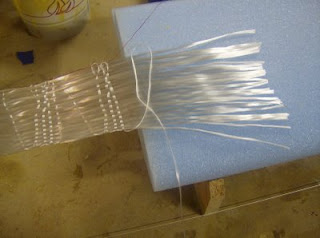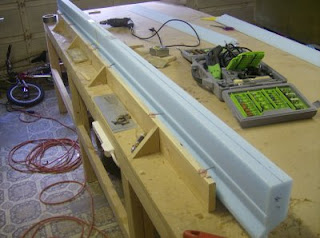My brother decided to start a project of his own about a month ago. He bought a '78 Datsun 280Z. Unfortunately it has been stuck here at my home until he can get it road worthy. Not that I mind much, but his "Z project" has been a distraction, or more really a diversion away from the my "EZ project" these last few weeks. Hence no blog update in a while. However I have been making some progress and the main canard is glassed. Also thanks to his help I have some machined parts for nearly free thanks to Deano and Jeff, my brothers co-workers that machined them for me.
Here is the canard bottom after glassing. You can clearly see the copper pipe used to keep the foam straight during the glassing process. A thicker steel pipe probably would have been preferable, but this copper pipe was available.

Here I am cutting off the foam "fish tail". Without this extra foam the trailing edge would be far to delicate prior to glassing.
Just after removing this foam I realized a frustrating mistake I made. The newer Roncz plans call for a 1" wide strip of peal ply to the trailing edge just prior to glassing the bottom. However the original plans clarify this and tell you to apply the 1" peel ply only halfway onto the trailing edge. Unfortunately I did not catch the later point and was left with one full inch of peel ply to remove from between the bottom glass ply and the training edge foam. The result was quite a bit of damage to the foam core. This caused me some deal of grief, but the next day I masked off 1/2" of the trailing edge glass and repaired the foam with dry micro. The result was acceptable and I happily continued with glassing top spar cap and skin.

Here you can see the top spar cap laid up. Also visible is the yellow micro repair to the trailing edge and the higher density foam inserts to later receive the aluminum elevator hinges

A close up view of the elevator torque tube machined to receive the NC-2 insert pictured (gold colored part). The smaller hole will recieve a stainless steel hinge pin while the larger hole is mearly to accept a pop rivet that will secure the NC-2 into the torque tube. These parts were machined by my brothers co-workers, Deano and Jeff.

Finally here is the canard fully glassed and waiting for the elevator and swoopy tips. The plans call for the canard to be stored leading egde down and I have made every attempt to save the waiste foam from when the cores were made for purposes such as this.
























































